Water and Shadow: Kawase Hasui and Japanese Landscape Prints

“Nishimikawazka, Sado Island,” 1921
A screen of snow, a curtain of rain, a spring shower, a sunset behind a bridge in summer: all vivid images created by the Japanese printmaker, Kawase Hasui (1883-1957). In the newly modern Japan of the early decades of the twentieth century, Hasui and his fellow shin-hanga (“new print”) artists—still relying on the exacting methods of full-color woodblock printing techniques—created stunning landscapes and evocative glimpses of everyday life,.

“Snow at Golden Pavilion,” 1922
Carolyn Hsu-Balcer and Rene Balcer have given their magnificent collection of hundreds of Hasui’s prints, paintings and printed ephemera to the Virginia Museum of Fine Arts in Richmond, Virginia. Spanning the entirety of Hasui’s career, the collection includes rare work made before the great earthquake of 1923 which tragically destroyed vast numbers of his notebooks, paintings, woodblocks, and prints.
The Balcer collection is on view at the VMFA until March 29, 2015. It’s a huge and hugely absorbing show.

“Evening Snow at Terajima,” 1920
Here, fresh images of every day Tokyo life and scenes of the artist’s wide-ranging travels are infused with a hushed beauty and complexity. This subtle layering of composition, color, and texture is all the more astounding when you—thanks to a film showing continually—are made privy to the process of collaboration between artist, woodblock carver, and printmaker.

“Snow at Zojo Temple,” 1922
First, the carver, in a process that can take up to two weeks, creates the “key block” from a watercolor design pasted to the woodblock. Subsequent “color blocks”—up to a dozen or more, depending on the number of colors the artist wants in the finished print—are meticulously carved. The printmaking process itself is as exacting as is the carving. The results dazzle, not only technically, but in the range of feelings the works arouse in the viewer.
In several instances we see the evolution of an image, as in the case of “Nishimikawazaka, Sado” (from Souvenirs of travel, Second Series, 1921). A preliminary watercolor, a mid-range version, and a later edition are on view side by side, with the artist’s choices regarding composition, texture, and color evident in each. Here we see the midrange version woodcut, part of the Balcer gift to the museum.
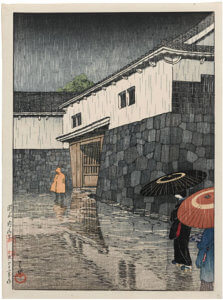
“Uchisange, Okayama,” 1923
Once you’ve learned a tiny bit about the printmaking process, you will stand, open-mouthed, in front of “Snow at the Golden Pavilion” (from Selection of Scenes of Japan, 1922.) Each swirling snowflake was cut around and raised, giving the scintillating effect of falling snow.
In “Evening Snow at Terajima Village” (from Twelve Subjects of Tokyo, 1920), we move from the other worldly shimmer of the golden pavilion to an equally enchanting, but far more prosaic scene of a Tokyo canal neighborhood, with its lantern-like windows and parade of telegraph poles.
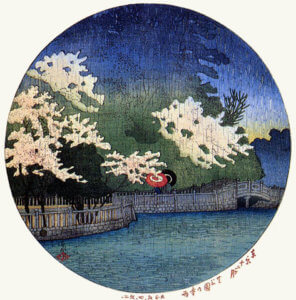
“Spring Shower in Shiba Park,” 1921
“Snow at Zojo Temple, 1922” was the very first Hasui print collected by Rene Balcer. “I had been that figure making his way across a snow-swept park,” he says in the richly illustrated exhibition catalogue. As February refuses to quit, haven’t we all been that figure? This elegantly spare, very modern image evokes a shudder as icy flakes intrude behind the collar of the overcoat.
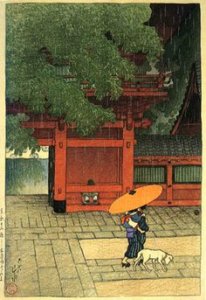
“May Rain at Sanno Shrine,” 1919
Hasui was also a master of depicting rain, as we see in “Uchisange, Okayama” (from Selection of Scenes of Japan, 1923). The figure in the yellow slicker morphed from one in traditional Japanese dress in an earlier etching. Further editing in two subsequent versions results in this startlingly graphic image, the yellow figure standing like a semaphore in the teeming rain.
Lest you think spring will never come, “Spring Shower in Shiba Park” (from Twelve Months of Tokyo, 1921) should cheer you. I love the floating clouds of cherry blossoms, abstracted to such a degree they appear to be underwater coral reefs. And oh, those parasols, blooming like poppies in the rain.

“Kami(no) Bridge, Fukagawa,” 1920
“May Rain at Sanno Shrine” (from Twelve Subjects of Tokyo, 1919) gives us a charming scene of a woman, a baby on her back, hurrying her little dog through a fine spring rain. They pass a mysterious figure, hunched in the shelter of the solid bulk of the shrine. A begger? A monk?
Hasui’s mastery of light is evidenced in “Kami(no) Bridge, Fukagawa” (from Twelve Subjects of Tokyo, 1920). This luminous view of river, boats and buildings framed by the bridge allows us to share Hasui’s delight in an everyday stroll through the city.

“Shinkawa at Night,” 1919
“Shinkawa at Night” (from Twelve Subjects of Tokyo, 1919) is a mysterious, almost foreboding image. The brilliant light emanating from between the two buildings hints at the supernatural, as the early stars emerge from a cobalt summer sky.
Coming fully into the sunshine, at last, we bask in the charming “Komagata Embankment” (Twelve Subjects of Tokyo, 1919). The driver and his placid horse drowse in an early summer day, having presumably worked very hard at bundling up all that bamboo. The bundles act as a screen, allowing us a glimpse of tranquil water, buildings and sky beyond.
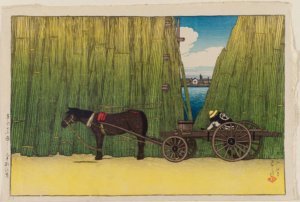 As you’ve seen, Kawase Hasui created works that dazzle technically, but also touch the viewer, never to stooping to the commercial or banal, but finding a still place to contemplate nature and man’s (and woman’s) place in the world.
As you’ve seen, Kawase Hasui created works that dazzle technically, but also touch the viewer, never to stooping to the commercial or banal, but finding a still place to contemplate nature and man’s (and woman’s) place in the world.
The show is well-worth the drive from the DC metro area–and it’s free!
If you do go, try to make it on a Thursday or Friday when the very, very good restaurant, Amuse, is open. Have cocktails in front of the floor-to-ceiling windows and watch the sun set behind the silhouetted trees. You’ll feel you’ve entered the floating world of Kawase Hasui.
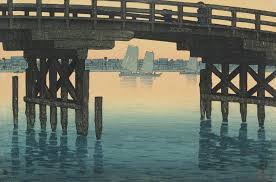
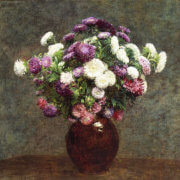

Leave a Reply
Want to join the discussion?Feel free to contribute!